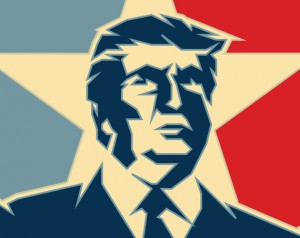Trending
What Trump’s lawsuits say about how he’d govern: Trump v. Partners and Rivals
Part III of TRD's dive into the GOP front runner's legal history

From the April issue: Donald Trump is on the verge of claiming the Republican nomination for President of the United States.
In this month’s issue, The Real Deal took a deep dive into Trump’s litigation history, focusing mostly on Manhattan real estate. We reviewed hundreds of cases filed in Manhattan courts between the early 1980s and last month that involved Trump or one of his business entities. The suits also offer a window into his temperament — beyond the campaign bluster — and into how he would conduct himself as the leader of the free world.
Below is the third web installment of a story that looks at decades of Trump’s legal battles and how he handled each one.
The Empire State Building brawl
At one point or another, Trump has owned part, or all, of The Plaza Hotel, the Grand Hyatt, the GM Building, Riverside South and the Empire State Building. But he’s gone multiple laps around the courthouse with his partners at each property.
In 1994, Trump acquired a 50 percent interest in the Empire State Building from Japanese billionaire Hideki Yokoi for a paltry $100,000, according to the Wall Street Journal. But his presence had a very strategic purpose: Yokoi’s daughter, who was fighting with her father over control of their iconic investment, wanted Trump to help break the lease. And what better way to do that than to sue?
Indeed, a partnership between the Malkin and Helmsley families controlled a 114-year lease on the Empire State Building, meaning almost all the profits from rent would go to them and not to the owners. That’s where Trump came in.
Trump was brought in to sue the Malkins and Helmsleys. And he did so in spectacular fashion, with a price tag of $100 million, claiming they had allowed the prized landmark to become “rodent-infested” and a “high-rise slum.”
The suit, which provided much fodder for New York’s press corps, was a bold attempt to break a lease that was set to run until the year 2076. The Helmsleys and Malkins fired back with a $100 million suit, in which they hit Trump where it hurts most: his image. “Trump has no meaningful financial resources of his own” and is “now known mostly as a celebrity,” the claim read.
Neither side got their $100 million, and Trump and Yokoi both sold their stakes to the Malkins in 2002.
“I think most people doubted that Trump’s lawsuit would go anywhere. It’s incredibly difficult to break a ground lease in New York,” said Hannigan, who represented Trump in the eventual sale.
Trump, however, had little to lose and a lot to gain. In addition to buying his stake at a nominal fee, he had negotiated a deal with Yokoi to get 50 percent of the sale for anything over $45 million. When the partners sold to the Malkins, the price was $57.5 million — meaning Trump earned more than $6 million. “[It] ultimately paid off handsomely for Mr. Trump,” Hannigan said.
Still, while he may have gotten a big payday, he lost the building.
“I’m sure he wanted to hold on to the icon, and that was his goal; that’s how he thinks,” said one attorney, who asked to remain anonymous.
‘Grand’ ambitions
Meanwhile, in 1993, just before his Empire State Building acquisition, Trump slapped his partner, hotel magnate Jay Pritzker, with a $500 million suit, claiming that Pritzker was trying to force him out of their partnership at The Grand Hyatt On East 42nd Street.
Pritzker had wanted Trump to evenly split the $37 million in renovations being done at the site. But that was $18.5 million that Trump, who was in hot water with his creditors in Atlantic City, may not have had at the ready.
“As Donald saw it, and he may have been right, Pritzker knew Trump had no money because it was all over the papers that he was on the verge of bankruptcy,” one lawyer recalled. “So since Donald couldn’t make his partnership share of those [renovation] payments, he would have lost his interest in the hotel. So he sued them.”
Trump also claimed that Pritzker had siphoned millions from the hotel and overstated profits. Pritzker countersued for $100 million, saying that Trump had tried to block hotel renovations by not paying his share.
The two settled in 1995 and the following year Trump sold his interest in the Hyatt to Pritzker for $140 million. “It’s both a very happy and very sad day,” Trump told the Times.
GM goals and West Side dreams
In a more famous example of sue-then-sell from 2001, Trump went after his then-partner Conseco Inc., the financial firm, to the tune of $1 billion for refusing to sell him the GM Building. Trump was later successfully able to force a settlement, despite the fact that an arbitration panel had ordered him to sell his stake in the building to Conseco for $15.6 million. Sources at the time told the New York Post that Trump may have made out with over $100 million as part of the settlement agreement, but the New York Times reported that his payout was expected to be “modest” when Conseco sold the building.
Fast forwarding to 2005, Trump took on one of his biggest (and now most well-known) fights — this one on Manhattan’s West Side.
Extell Development, Carlyle Group and partners had entered into contract to buy a 13-block-long development site known as Riverside South for $1.76 billion. Trump had first optioned the site in 1974, and he had already built on it, erecting a collection of condo buildings known as Trump Place with partners led by Hong Kong billionaire Henry Cheng.
Trump was by then only a minority owner in the available land and did not know that his partners, the majority stakeholders, had agreed to sell the property.
When he did find out, he took action. Despite the expectation that he would get a hefty $500 million out of the sale, he sued the partners for $1 billion for allegedly underselling the site and thus violating their fiduciary duty to seek the highest possible price.
According to Trump’s suit, Cheng and others didn’t consider offers from Colony Capital and developer Richard LeFrak (one of Trump’s close friends) for $2.9 billion and $3 billion, respectively, which a judge found to have been merely expressions of interest and not true offers. With 19 of 20 claims dismissed, the sale was allowed to continue.
But Trump was unwilling to let Riverside South go. Instead, he kept suing.
In 2008, he alleged that Extell and Carlyle had wired $17.5 million as a bribe to the partners to sell the partners the site for more than $1 billion less than what Trump thought it could have fetched.
Extell CEO Barnett later told New York magazine: “What, you think [the Chinese are] giving up a billion dollars in order to cheat Donald out of $17 million? The whole thing’s a joke.”
It wasn’t until nine years after the sale, in 2014, that an appellate level court finally put the entire case to bed when it dismissed Trump’s last appeal, according to a remittitur document reviewed by TRD.
Regardless of the sums Trump ended up with in each of these conflicts, they all resulted in him selling his interest in a Manhattan property. Those sales undoubtedly made Trump richer, but they also made his Manhattan real estate footprint smaller.
Kyna Doles contributed research to this story.




